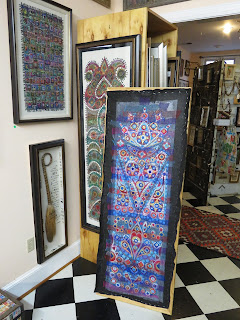Yesterday was grand! I got to tackle another gigantic space with The Wall of Ancestors. This show is inside the Etherredge Art Center on the University of South Carolina-Aiken's campus. I brought all 275+ framed images, placed several of the largest ones in the center of the four large sections, and started arranging enormous vignettes. There are twenty-two 8' x 4' panels along this wall. That's a total of 88 linear feet. It took six hours to unload into the elevator, haul the work to the space, and hang everything. Yet, this is what I imagined back in 2014 when my obsession started. (I blogged at The Wall of Ancestors HERE ... when there were only 127 total pieces). I knew I wanted to have more pieces, more work from which to select, and not have to hang every single one!
(Above: Buttons!, my other solo show hanging in the lower level of the Etherredge Art Center.)
I didn't hang my other solo show, Buttons! Ann Bliss, the gallery director, hung the twenty-three pieces in this simultaneously running exhibit. This wall is on the lower level of the Etherredge Art Center. It consists of thirteen 4' x 8' panels for a total of fifty-two linear feet. It is also the first time I've mounted my button inspired work.
(Above: Most of the first section of The Wall of Ancestors. The total number of framed photos in this section is seventy-seven.)
Hopefully, lots of people will see the shows. This weekend is student orientation. The place should be crowded. I came home with a total of thirty-one pieces that didn't find a place on the wall. If I counted correctly, 246 pieces were hung. It is nice to have "more than enough". It makes the job of composing a nice arrangement so much easier.
(Above: The second section of The Wall of Ancestors. There are forty-five framed pieces.)
The press release covers both exhibits, but the paragraph on The Wall of Ancestors reads:
The
Wall of Ancestors, a collection of anonymous photographs, is the
centerpiece of Susan's larger installation, Anonymous Ancestors.
Each image has been altered with letters clipped from vintage
ephemera. The selected phrases suggest a fictional narrative. An
image of an early 20th century infant propped up on a fancy wicker
chair reads, "I didn't live to adulthood". Another
snapshot of a feisty bathing beauty reads, "I never wore a seat
belt". A couple staring blankly out of their antique frame has
the caption "Virgins on our Honeymoon Night". There's
"Pillar of the Community" and "Spinster Sisters"
and "Home Sweet Home: Address Unknown". There are over
two-hundred individual works in Lenz's collection. Together, these
closely hung, framed works encourage viewers' minds to wander,
envisioning forgotten friends, past holidays, ancient occasions,
former cars, and hilarious fashion trends.
The press release paragraphs for Buttons! reads:
Buttons!
is a brand new exhibition. The mixed media work is Lenz's response
to an art administrator's harsh criticism of her "Button"
art residency proposal. Told that her work romanticized materials
and didn't push boundaries as a professional studio artist, Lenz
fought back in the only manner she could. She made art. She also
got a 2017 summer art residency at Homestead National Monument in
Nebraska where much of the work was created. "I am indebted to
the criticism. It forced me to go beyond the scope of my initial
proposal. It made me admit that I do romanticize my materials. In
fact, I count on the public's nostalgic association with this humble
object. There's nothing wrong with this. Also, I do push
boundaries, but this time I pushed a lot harder and the effort paid
off," says Lenz.
Since
her National Park residency, Lenz has continued to use the seemingly
insignificant clothing button to communicate issues of gender, race,
politics, relationships, and personal narratives. "My work
explores the many functions and possibilities of these ordinary
objects while challenging viewers to see buttons as more than
utilitarian fasteners". Included in this exhibition are several
vintage typewriter advertisement and xylene photo transfers of
cemetery angels surrounded by hand-stitched buttons. His Secrets
and Her Secrets each feature forty, crowd-sourced,
close-up snapshots of mouths on which large red and pink buttons are
stitched.
(Above: Buttons!, including His Secrets and Her Secrets, a button covered vintage typewriter advertisement, and three from the series "The Button as Art", altered antique images from the 1893 Columbian Exposition ... the latter of which I blogged about HERE.)
(Above: Buttons!, including The Virgin of Gone and Forgotten plus four pieces from the series Waste Not Fresh Tears ... which were created during my art residency at Homestead National Monument in Nebraska.)
(Above: Buttons!, including Silence is Golden I and II, four of the Buttons as Art series pieces, and other work.)
I am linking this post to Nina-Marie's "Off the Wall Fridays", a site for sharing fiber arts.

























































